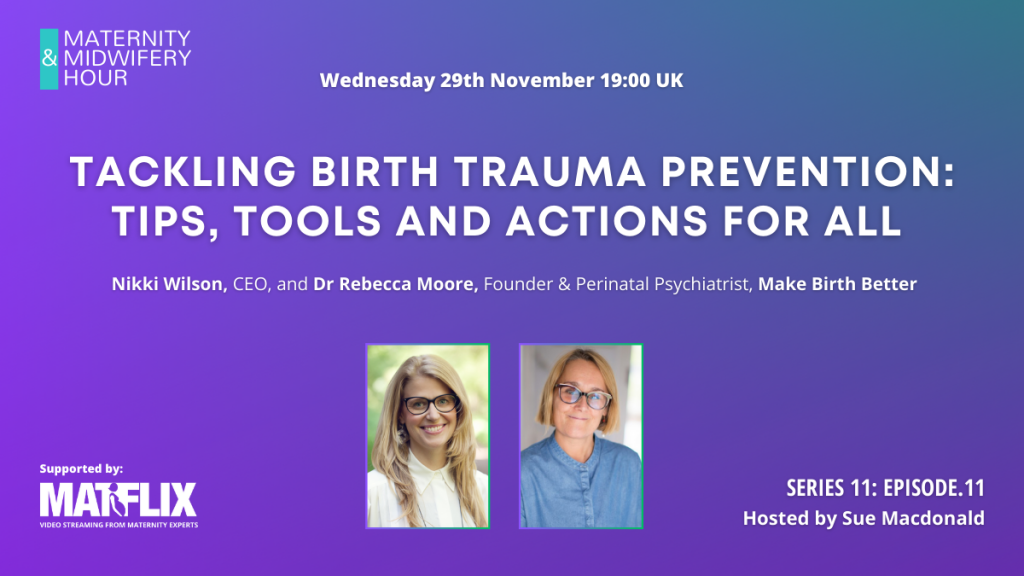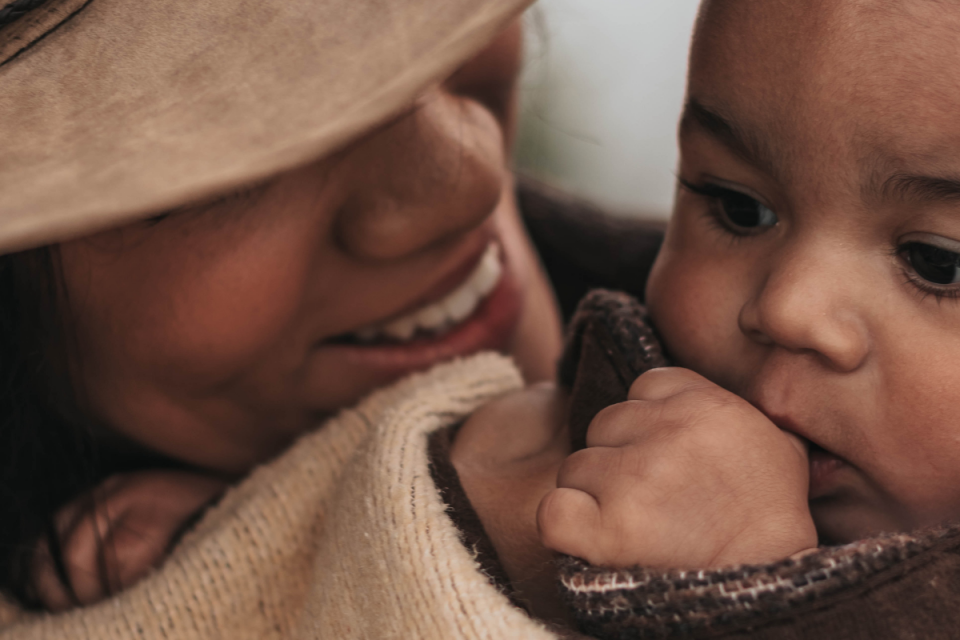Understanding and awareness of traumatic experiences of pregnancy and birth has emerged and developed in recent years. This includes those of maternity staff. The topic was recently debated in the UK parliament. In this article Evelien Docherty Communications Lead at Make Birth Better discusses the concerns and frames what can be done to prevent trauma in the first place.
_________________________________________________
Up to 40% of women and birthing people in the UK experience their birth as in some way traumatic (research shows a range of 25 – 40%). Many of these people will experience post-traumatic stress symptoms. Up to 10% of those who give birth each year will meet the clinical diagnosis for Post Traumatic Stress Disorder (PTSD (research shows a range of 4.6-10%).
In many cases birth trauma is preventable. As a healthcare professional: are you aware of what you can do to prevent birth trauma or minimise its impact?
We will cover this question in-depth during the Maternity & Midwifery Hour on Wednesday 29 November featuring Make Birth Better Co-founder Dr Rebecca Moore and Make Birth Better CEO Nikki Wilson. Please sign up here: ‘Tackling birth trauma prevention: tips, tools and actions for all’.
What is birth trauma?
Before we delve into preventative action: let’s start at the beginning. What actually is birth trauma?
Birth trauma describes symptoms of trauma related to the birth itself and/or circumstances around the birth.
But trauma is known to be a big word that doesn’t resonate with everyone.
What we really mean is that you felt intensely afraid, fearful, out of control or helpless when you were giving birth, when you were pregnant (or trying to get pregnant) or after you had your baby. And that this has left a lasting imprint on you mentally and/or physically.
Why the words ‘birth’ and ‘trauma’ are not always useful
The words ‘birth’ and ‘trauma’ are not always the most useful because we can wrongly assume that we’re exclusively talking about a distressing birthing experience. Because we’re talking about the symptoms which might present at any stage in someone’s perinatal journey, we actually prefer the term perinatal trauma as this more broadly describes symptoms of trauma related to the whole perinatal journey.
If we look at the circumstances around the birth this might include: infertility diagnosis, recurrent pregnancy loss and the impact of fertility treatment (often called ‘reproductive trauma’); Hyperemesis Gravidarum; and increasingly, it is being recognised that for some, breastfeeding, or not continuing breastfeeding, can be a traumatic experience.
It is important to be clear on these nuances as we move into preventative action. You can read more on birth trauma and the four symptoms to look for on the Make Birth Better website here.

Three areas where preventative action is possible
As mentioned, birth trauma is often preventable. What can you do in your day-to-day practice to prevent birth trauma or minimise its impact? We’ve chosen to pick out three areas to focus on:
1) Advocating for systemic change and looking after you
We cannot address birth trauma prevention without talking about the wider system and how everyone within that system has a role to play in reducing the impact of birth trauma. And currently, we are looking at a system that is failing everyone involved in it far too often – babies, parents, wider families and professionals too. Imagine what we could achieve if we would address each layer in the system to make sure everyone feels looked after, safe and supported. This is the focus of our Make Birth Better model.
What we see right now, is that maternity services are underfunded, understaffed and under a lot of pressure. The cost of caring is simply too high:
- 67% of midwives suffering from work-related burnout (UK WHELM study)
- 8 in 10 midwives say they do not have enough staff to run a safe service (RCM Study)
- Top three reasons midwives leave (REMAIN study):
1) Insufficient staff (87%);
2) Impact on mental health (79%)
3) Burnout/emotional distress (78%)
“People are coming into a traumatised system which is often firefighting with little space for individual needs.”
Dr Emma Svanberg, Make Birth Better Co-founder & Perinatal Psychologist
Knowing we are dealing with a systemic issue here might make it feel like the status quo is hard to change – and of course to some level that is true. We are depending on Government funding, an awareness amongst staff and a collective willingness to drive change. But it is not all out of our control.
It is possible to consider how you might make your team meetings more trauma-informed meetings or ensure reflective practice groups are established and working well. It is possible to re-enforce authentic human connection in teams because how we connect makes a real difference. We cannot operate as emotional islands.
It is possible to equip ourselves and others with small, simple wellness actions which can be incorporated into day-to-day routines. And to know when the level of someone’s suffering requires a lot more than that.
It is also possible to contribute to on a larger scale as a changemaker. At Make Birth Better we galvanise the passion of parents and professionals and encourage people to become Make Birth Better Champions or join our campaigns No More Excuses and Think Trauma Now.
2) Holding in mind the susceptibility factors within a trauma-informed framework
Anyone can suffer from birth trauma, but research has been able to identify those who are more susceptible. There are a lot of factors to consider in here. Here are just a few of the things to hold in mind as professionals.
We know susceptibility to birth trauma is higher amongst people living in marginalised groups (e.g. those who are Black, brown or racially minoritised, LBGTQIA+ folks, people who are displaced or seeking asylum, people who are disabled); people affected by previous adverse experiences (such as: sexual abuse, previous baby loss, lack of support); people with pre-existing mental health conditions (known risk factors include: depression during pregnancy, tokophobia (an intense fear of childbirth), a history of PTSD or previous birth trauma); people facing housing and financial challenges (e.g. American research shows that for women on lower income there is more incidence of birth trauma and low birth weight babies).

During the session ‘Tackling birth trauma prevention: tips, tools and actions for all’ Dr Rebecca Moore and Nikki Wilson will cover this more in-depth – they will also share some universal precautions when it comes to supporting a client with a history of sexual abuse (suggested by survivors of childhood sexual abuse); steps to help reduce inequalities in maternal care and five tips from Bunty Lai-Boyd (Midwifery Senior Lecturer & specialist in autonomy, LGBTQ+ visibility & inclusivity in education).
However, it’s not enough to be looking out for people who might fit neatly into the box of a certain vulnerable group. This approach doesn’t acknowledge that:
- factors intersect and overlap creating many different circumstances
- we all hold bias which leads us to make assumptions and act accordingly
- many (if not most) will not feel safe enough to disclose their struggles
Instead, we have to look at care through a trauma-informed lens. This means that everyone in the care system (staff and service-users) needs to be cared for in a way which respects the widespread impact of trauma. We need to create a healthcare system which “understands potential paths for healing; recognises the signs and symptoms of trauma in staff, clients, and others involved with the system; and responds by fully integrating knowledge about trauma into policies, procedures, practices, and settings and seeks to actively resist retraumatisation.”(SAMHSA: Key Ingredients for Successful Trauma-Informed Care Implementation here).
3) Improving communication to minimise harm and promote healing
It’s easy to minimise communication as a soft skill. One that matters less particularly when we’re dealing with circumstances around life or death. However, humans are always receptive to the environment they are placed in. If someone is met with ambivalence, dismissal or even hostility, this alone is enough to make a difficult experience traumatic.
“Poor communication contributed to 9 in 10 cases of birth trauma.”
Birth Trauma Association Survey, 2020
Interpersonal skills are a critical factor in birth trauma prevention. Language matters and non-verbal communication matters equally too. Often at Make Birth Better we hear stories from parents who can pin-point the hotspot of their trauma to something as seemingly small as eye-rolling, tutting, limited eye contact or folded arms.
When we work in a high-stress environment, it’s easy to understand why compassion fatigue kicks-in and how attention to the details of how we interact with one another becomes lost. This is why we have to regularly revisit this topic, raise the value of it in training and have open conversations about language that caused harm and equally as important, language which created healing.
Our #everywordcounts campaign encourages everybody to reflect on the impact of words: it shows the impact of words, but also how simple the solution can be.
All of the above will be covered more in-depth on Wednesday 29 November by Dr Rebecca Moore and Nikki Wilson, for now we’re leaving you to reflect on this video from our #everywordcounts campaign.
Evelien Docherty
Communications Lead at Make Birth Better
November 2023
Sign up for the Midwifery Hour on 29 November – REGISTER FREE HERE
The Midwifery Forum’s weekly live stream, brought to you by MATFLIX – every Wednesday, 7-8pm London, UK (BST)
Birth trauma is often preventable. In this session Perinatal Psychiatrist and Co-founder of Make Birth Better Dr Rebecca Moore and Make Birth Better CEO Nikki Wilson will talk you through tips, tools and actions that every healthcare professional can take to reduce birth trauma. Together with service user voices, Rebecca and Nikki will cover susceptibility to birth trauma, trauma enquiry, consent, communication and more.



